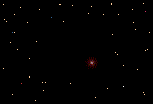The Sun, the center of our Solar System, is a million
times larger in volume than our Earth and contains 99.9 % of the mass of the
Solar System. It provides the light and other energy that we need to live.
The layer of
the Sun that we see on a normal day is called the
photosphere,
which simply means the sphere from which the light comes (from the Greek
"photos", meaning "light"). As is typical from many stars, about
94 % of the
atoms and nuclei in the outer parts are hydrogen, about 5.9 % are helium,
and a mixture of all the other elements makes up the remaining one-tenth of
one per cent. The overall composition of the interior is not very
different, though deep in the core helium is being formed out of hydrogen
nuclei. The core, which is about 10 % of the solar diameter at this
stage of the Sun's life, is the place where all the energy is generated.
The temperature there is about 15 million
0C. The energy is generated in the Sun by nuclear fusion in
the Sun's core. In the deeper parts of the Sun, energy is carried out by
radiation. Above that region, in the upper part of the of the solar
interior, energy is carried by convection, the way that matter moves when is
heated below and carries energy as it moves upward against gravity.
Just above
the photosphere is a jagged, spiky layer about 10,000 km thick, only about
1.5 % of the solar radius. This layer glows colorfully pinkish when seen at
an eclipse and is thus called the cromosphere (from the Greek
"chromos", meaning "color". Above the chromosphere, a ghostly white halo
called the corona (from the latin, menaing "crown") extends tens of
millions of kilometers into space. The corona is continually expanding into
interplanetary space. What we call the solar wind is based on this
expansion.
When we
study the Sun in white light - all the visible radiation taken together -
with 1 arc second resolution, we see a salt-and pepper texture, called
granulation, and sunspots. The granulation effect is similar to that seen in
boiling liquids on Earth, which are undergoing convection. Each granule is
only about 1000 km across and represents a volume of gas that is raising
from and falling to a shell of convection, called the convection zone,
located below the photosphere. The sunspots are the most obious sign of
solar activity. They are areas of the Sun that appear relatively dark
because thay are giving of less radiation than the phtosphere that surrons
them. This implies that they are cooler areas of the the solar surface,
since cooler gas radiates less than hotter gas. Actually, if we could
somehow remove a sunspot from the solar surface and put it off in space, it
would appear bright against the dark sky; a large one would give of as much
light as the full moon. Suspots were discovered in 1610, independently by
Galileo in Italy, Fabricius and Christopher Scheiner in Germany, and
Thomas
Harriot in England. The number of sunspots varies with an 11-year cycle,
called the sunspot cycle. Sunspots are thought to be a result of
differential rotation winding up the Sun's magnetic field. Every 11-year
cycle, the north magnetic pole and south magnetic pole on the Sun reverse
polarity; what had been a north magnetic pole is then a south magnetic pole
and vice versa. This changeover occurs a year or two after the number of
sunspots has reached its maximum.



